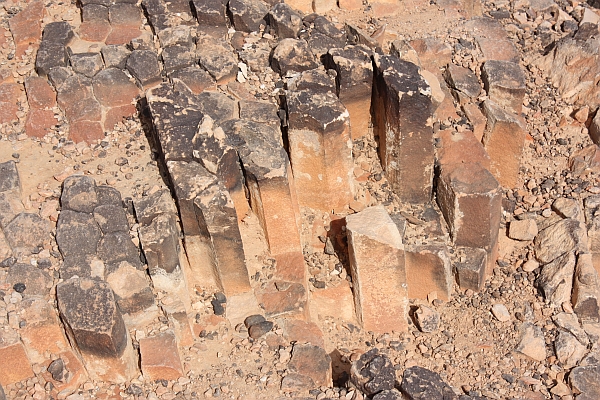Columnar basalt is definitely beautiful and interesting rock formation but it is nothing new to a seasoned geologist. Columnar sandstone, however, is probably different story. I had never heard anything about such rocks when I accidentally just stumbled upon one.
There is a large “crater” named Makhtesh Ramon in the Negev Desert in Israel. It is described as the largest makhtesh in the world. That really sounds impressive until you learn that these landforms actually occur nowhere else than in the Negev desert.
So it is simply largest in the Negev but it is impressive anyway. What is makhtesh? It is neither a meteorite crater nor is it a volcanic caldera although it is frequently described as a crater. It is an erosional landform of a structural dome which has softer rocks (sandstone) below and harder (limestone) on top of it. Intermittent rivers called wadis erode the softer rocks faster and create sharp escarpments like crater walls. Makhtesh Ramon has pretty impressive measures. It is 40 km long, 2-10 km wide and 500 meters deep.
Makhtesh Ramon no doubt is worth a visit in its own right but I was most impressed by what I saw in the middle of the makhtesh. There was a hill made of sandstone. But what kind of sandstone! It was like a huge pile of columnar logs. No wonder that this hill is named Ha-Minsara (The Carpentry Shop).
I don’t know exactly how it was formed but I believe the mechanism had to be very similar to the formation of a columnar basalt. Something had to provide lots of heat. There are volcanic rocks nearby in the crater, so it probably was magma. What else could it be? After this baking episode the sandstone slowly cooled and cracks formed when the cooling rock mass contracted. I’d be glad to hear if anyone has a better explanation.
Here are some pictures of the Makhtesh Ramon and the Ha-Minsara in the middle of it.

The rim of the Makhtesh Ramon.





I can’t believe my eyes that this is indeed sandstone.
That is insane! What the heck is going on there to produce these columns?
What about the evolution of the columns being coeval with the doming episode?
It’s so weird…
I can’t believe it either! so bizarre I had to take a quick cruise around the web, I found several sites that suggest the sand was heated by nearby lava flows and fractured when cooling … but no detailed explanations nor references to research. I’d like to learn more but now I have to go skiing 🙂
http://en.wikipedia.org/wiki/Makhtesh_Ramon
http://www.flickr.com/photos/nonlin/3773266795/
Unreal! I’d like to know what the grain cement is–that’s gotta be a big part of what’s going on. Maybe it’s something like a smectite clay that got roasted, driving off the adsorbed water, causing the whole mass to shrink when it cooled? Pure speculation.
Skiing is a nasty job, but *somebody* has to do it, right? I was doing it last Friday–woohoo! 🙂
My guess would be de-vitrified volcanic glass, but I’m sure closer inspection would prove me wrong…
This place sounds incredible, more like a dream place to me. I agree with Howard, the cement of the sandstone does seem to be important. Smectite clay is a good speculation. I was also wondering how the columnar basalt looks like in thin section. Does it resemble a quartzite or quartz arenite? Protolith would be good to know at least. Are there more of these in the Negev desert?
Totally missed that. *Columnar sandstone* not basalt…
These structures also occur in sandstones in the Parnaíba Basin, northeastern Brazil, caused by heating related to basalt flows and subsequent cooling. So it seems like a good guess.
Beautiful pictures!
Mathias, good to know that. Absence of evidence is usually result of our ignorance, not evidence of absence.
I personally tend not to put too much stress on the cement question. The most important thing to me seems to be that the sandstone is fine-grained and uniformly so. Otherwise such a beautiful columns would probably not form. These rocks had to be significantly heated to allow thermal expansion but not enough to melt them.
I have visited some of the columnar sandstones here in Paraguay. Cerro Koi is the most famous, but there are several other outcrops which are quarried. Here is a Facebook album of a couple of quarries in Luque, near the in Asuncion.
https://www.facebook.com/media/set/?set=a.10150257994616241.368151.623436240&type=3&l=5a9ced8cdb
One of the most interesting things I noticed is how easily the sandstone columns ‘peel’ off when they are wet. They absorb a lot of water and actually bend under their own weight – amazingly, the quarry workers can actually peel off exposed columns with their bare hands!
Ron, this is very cool. Thanks for sharing!
http://woostergeologists.scotblogs.wooster.edu/2013/07/09/the-carpentry-in-makhtesh-ramon-unexpected-columnar-jointing/
solves the mystery.